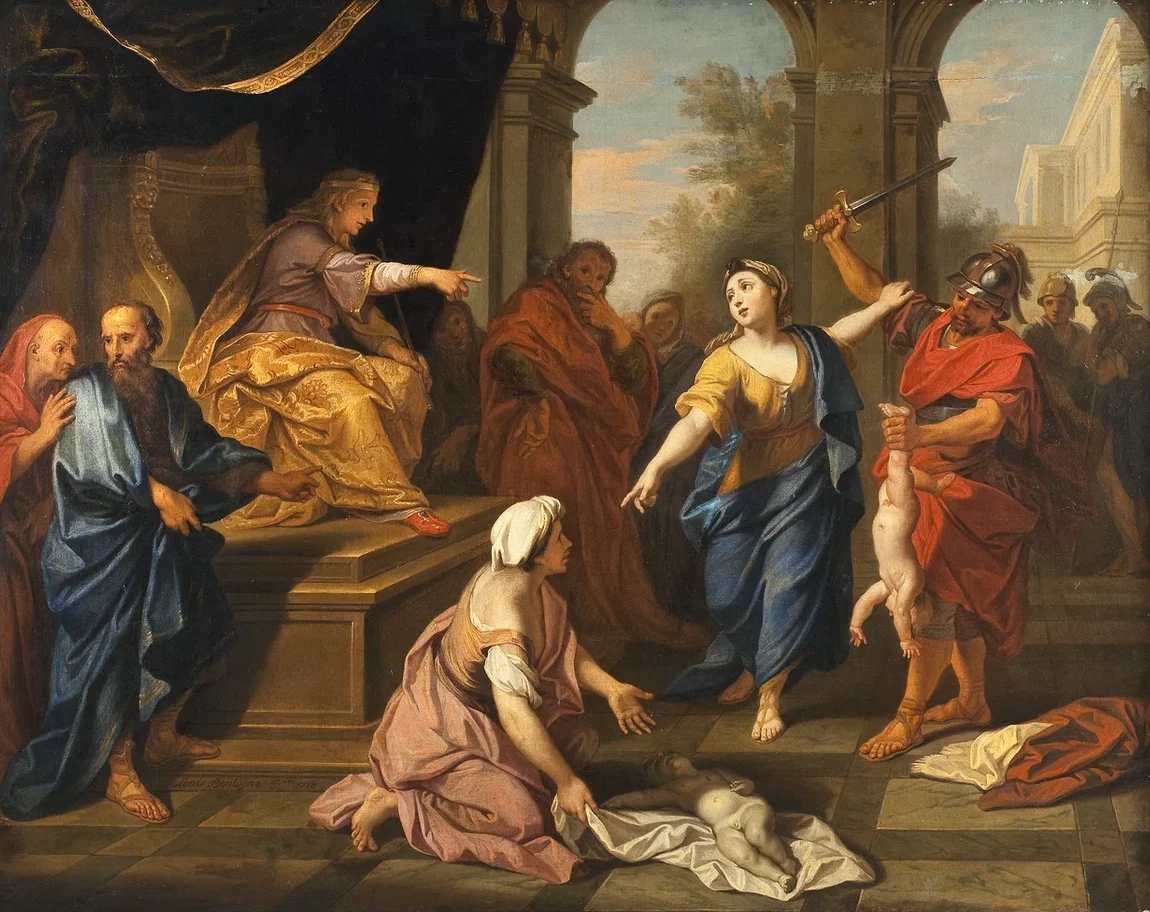Louis de Boullogne the Younger. The Judgment of Solomon. 1710.

The legal theme lies at the heart of Louis De Boullogne the Younger’s painting The Judgment of Solomon, which depicts the exercise of judicial authority by a monarch. The French artist’s work illustrates a biblical narrative—the trial of the legendary King Solomon of Judea.
During the monarchic period in ancient Israel, judicial power was held by judges and the king, who could adjudicate all disputes except religious matters. According to Old Testament tradition, King David (circa 1005–965 BC) appointed six thousand judges and scribes across various cities to oversee and administer justice in both religious and secular affairs.
The painting portrays the famous biblical story of a trial between two women, each claiming to be the mother of a living newborn. In the Jewish version of the tale, the two women were not merely acquaintances but a daughter-in-law and mother-in-law whose husbands had died. The family law of that time included the custom of “Yibbum” (levirate marriage), which required a surviving brother to marry his deceased brother’s childless widow to ensure the continuation of the lineage.
The only way a woman could be released from this obligation was if she had a living child who ensured the continuation of her deceased husband’s lineage. By recognizing the living newborn as the son of the mother-in-law, the court would simultaneously establish the child as the brother of the daughter-in-law’s deceased husband. This would have forced the daughter-in-law to wait many years—until the boy came of age—before he could either marry her or release her from the obligation through the ritual of “Chalitzah” (the removal of the sandal).
To resolve this family dispute, Solomon initially pretended to apply property law, ordering that the object of the dispute—the baby—be split in two, with each woman receiving half. He knew that the true mother’s love (in this case, the mother-in-law’s) would never allow such a monstrous injustice to occur. The daughter-in-law, however, had an interest in this outcome: the child’s death would free her from the obligation to wait for him to grow up. Thus, when the daughter-in-law agreed to the solution while the mother-in-law begged for the child’s life and offered to give him up, all doubts vanished. Solomon recognized the mother-in-law as the true mother, and justice prevailed.
In the painting, King Solomon sits on a throne adorned with lion reliefs—a symbol of Judea (ancient Israel) and Judaism. De Boullogne depicts lion heads on the backrest of the legendary king’s throne, emphasizing the ruler’s strength, courage, and leadership. Jerusalem, the capital of ancient Judea, adopted the lion as its emblem in 1950 when designing its new coat of arms, featuring a rampant lion.
One of the most famous symbols of King Solomon’s authority—absent in this painting—was his ring. According to legend, it possessed supernatural powers, enabling its wearer to command spirits, speak with animals, and even fly. The ring, or more precisely its inscription—"This too shall pass"—is tied to a well-known parable about Solomon. Some sources also refer to it as a seal, used to authenticate royal decrees and documents.
Louis De Boullogne the Younger came from a family of artists and trained in his father’s workshop from childhood, honing his skills and refining his craft. In his work, he rarely used traditional pencils, preferring instead to draw with black and white chalk on blue or gray paper, executing his sketches with freedom and refinement—whether in compositional studies or independent drawings.